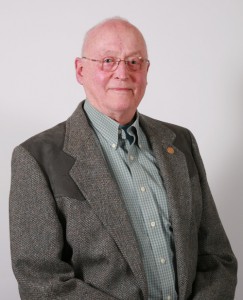Carl Benson honored for lifetime of service
November 8, 2012

Ned Rozell
11/12/2012
Last week, Carl Benson accepted a lifetime achievement award from the place he has worked since Dwight Eisenhower was president. As the 85-year-old snow and ice scientist and professor emeritus at the University of Alaska Fairbanks’s Geophysical Institute rose to applause from his friends and coworkers, memories rushed back to me.
One was the frigid January day he invited me along in his car to a busy intersection in Fairbanks. There, Carl used a spatula to shave dirty frost off a sheet of plywood he had placed in a snowbank earlier in the day. He later melted the residue to determine the unsavory ingredients of ice fog.
Another Carl memory is his badgering me for using “medieval units” like feet and miles in this column. He is perhaps the only person in Alaska with a driver’s license that lists his height in centimeters.
Carl was also the first person who told me how a political maneuver pushed Alaska farther out of sync with the sun. Upon Carl’s urging, way back when Bill Clinton was president, I wrote about the state’s “double-daylight savings time.” Since not many people (like me) remember the gist of that column, and the fact that we just turned back our clocks, I bring it up again here.
The Germans first used daylight savings time during World War I as a means to save energy; brighter nights in springtime meant people burned less coal for light. The U.S., including Alaska, adopted daylight savings time in 1967. In 1972, Arizona, Hawaii, Puerto Rico and part of Indiana opted not to recognize it.
In a perfect world, noon should be when the sun is highest in the sky. Each spring, daylight savings time knocks most of the U.S. one hour out of sync with the sun. In Alaska, Nome time is three hours off solar noon in springtime; Anchorage and Fairbanks are two hours off.
It wasn’t that way before 1983. That’s when Alaska’s delegation to Congress lobbied to change Alaska’s four time zones into the two we recognize today (one for the bulk of Alaska, Hawaii-Aleutian time for the islands west of Umnak). The idea was to get 99 percent of Alaska’s population on the same clock to better enable communications with the capital of Juneau. Before 1983, 5 p.m. Fairbanks-and-Anchorage-time was 7 p.m. Juneau-time (in World War II, Southeast Alaska was on Pacific Time to synchronize it with San Francisco and Seattle).
In those days, the U.S. and Canada had bought into an idea by Canadian engineer Sandford Fleming. Fleming divided the globe lengthwise into wedges, like a peeled orange. The 24 wedges each represented one hour and 15 degrees of longitude because it takes 24 hours for the earth to complete a 360-degree spin on its axis. The wedges became time zones, the borders of which squiggled to avoid large cities and towns.
Alaska covers 57.5 degrees of longitude, almost the same as the 57.6 degrees between Maine and Washington. Before 1983, the state covered four time zones: Bering, Alaska, Yukon and an unnamed zone in the far western Aleutians. When four Alaska time zones were transformed to two in 1983, noon didn't fit its solar definition in most of Alaska anymore. Daylight savings time pushed Alaska farther out of whack.
After falling back off daylight savings time recently, some of Alaska is not too far from the ideal. In early November, solar noon in Fairbanks is about 12:35 p.m. and Anchorage is 12:45 p.m. Juneau’s solar noon is 11:41 a.m, but Nome, way out west and a casualty of the political time zone change, experiences solar noon at 1:45 p.m. What Carl calls “double daylight savings time” (triple if you live in Nome or elsewhere in western Alaska) will resume next March 13, when we Alaskans will all vault another hour past solar noon.
Since the late 1970s, the University of Alaska Fairbanks’ Geophysical Institute has provided this column free in cooperation with the UAF research community. Ned Rozell is a science writer for the Geophysical Institute.


